While x86 server virtualization is now widely accepted as an important part of IT activity looking forward, the results of our recent workshop poll of Reg readers suggests that it is still early days when it comes to implementation.
As with all online polls, the respondents (301 for this one) were ‘self-selecting’, which means that the data collected represents a proportion of those with a particular interest in or knowledge of the topic. What we are looking at at therefore represents the ‘best case’ in terms of progress. Given that over 90% had some experience of x86 virtualization, however, the good news is that the feedback we received was far more likely to be informed, rather than based on guess work:
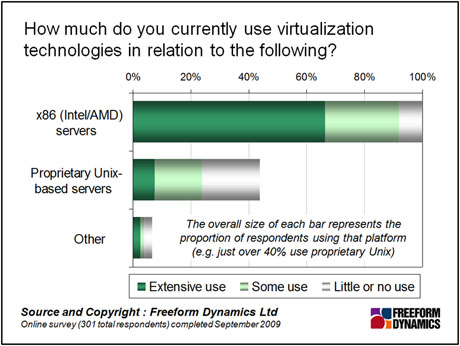
So what did we learn from the responses? To begin with, it is pretty clear that one of the major problems virtualization is envisaged to tackle, that of server proliferation, is very real. Over 85% acknowledged it overall, with only a third of the sample reporting that it was under control:
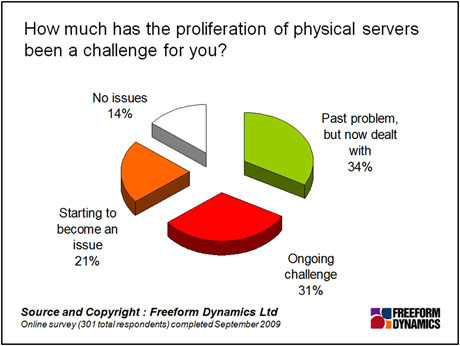
Why has server sprawl become such a widespread issue? The first cause that springs to mind concerns the traditional dependencies that have existed between applications and the platforms upon which they sit. A familiar challenge is how each application requires the underlying systems stack to be configured in a particular way, which is typically different to other applications. So too, is the problem of applications conflicting at execution time and interfering with each other in terms of performance or stability. These physical dependencies offer one of the main reasons why each application has traditionally lived on its own, dedicated server.
Server sprawl has had a number of consequences which ultimately relate to management efficiency and effectiveness. When we look at the challenges faced, we can see that a number of pain points exist that can be addressed through virtualization related initiatives:
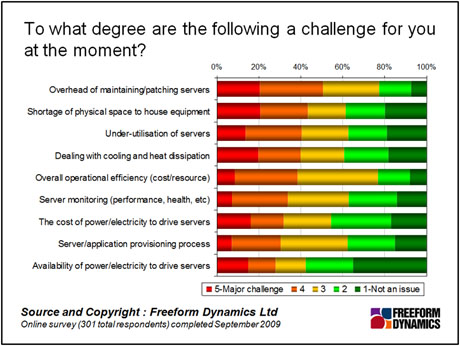
But feedback from readers confirms that there is another issue we need to bear in mind, which makes server consolidation, the antidote to sprawl, more than just a question of sorting things out technically. Almost half of those that responded said that the ‘systems ownership culture’ was an issue, in which each department or division has historically viewed the ‘whole system’ – that is, not just the application, but the underlying boxes driving it too – as theirs:
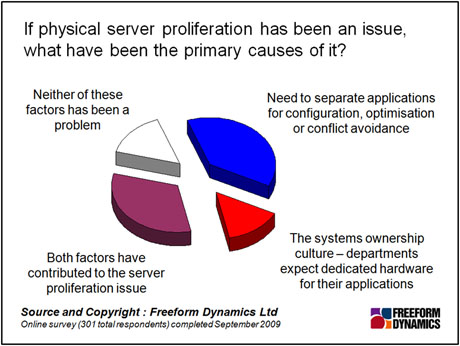
This and other feedback suggests that unlocking the full potential that virtualization clearly offers, even in terms of simple server consolidation, is in many cases going to involve negotiation with business stakeholders and finance guys to work through ownership issues and deal with the budgeting, cost centre accounting and other administrative mechanics that would otherwise stifle progress. Indeed, the ownership issue remains the most commonly cited challenge to consolidation initiatives:
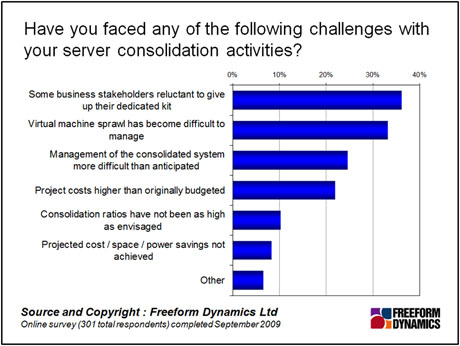
Beyond the politics and financial admin, we can also see some very practical issues highlighted on this chart. About a third of respondents, for example, say that once you have tackled the problem of physical server proliferation, a similar problem might sneak up on you in the form of virtual machine sprawl. The irony is that one of the great benefits of virtualization, i.e. the ability to create a new virtual server quickly on demand, means that the temptation is to just keep creating more servers.
Related to this, but also a potential issue even in a more disciplined environment, is the question of virtual server management. As has been discussed in our workshop [link], while the hypervisor part of the equation can often be acquired for little or no incremental cost, management tools have to be paid for, and this is currently an area that is often considered as an afterthought. Of course in an ideal world, you would want you existing operations tools to help you look after your virtual environment, but not all management suites are up to this, and one vendor at least, is still insistent on virtual server management being something that should be dealt with separately. Whatever your current capability and philosophy, however, the management question is clearly not one to be ignored.
The runaway costs that some allude to (which we can also see from the chart) are at least partly due to unanticipated management requirements, though other cost related factors that surfaced during our workshop included the need to upgrade network and storage infrastructure, and unintended impacts and complexity around software licensing.
But let’s not get hung up on the notion that these gotchas are major blockers. For every person that reported a challenge in each area, two or more said they hadn’t experienced the issue. In some cases, this may be because they have not arrived far enough down the virtualization road to discover some of the problems, but the general spirit we are picking up is that the pros far outweigh the cons however far you push things. With this in mind, it is not surprising that commitment to maintain or increase the use of virtualization technology is close to unanimous:
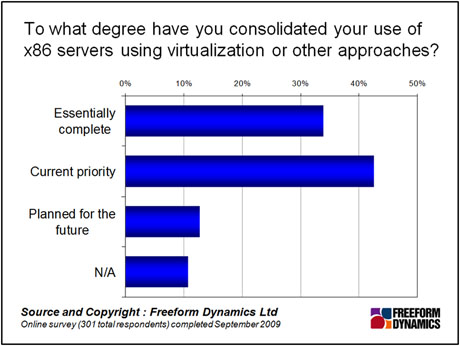
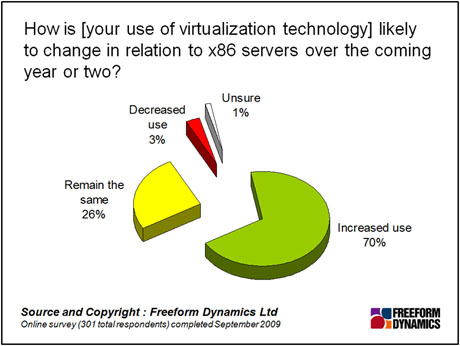
So, while the view of server virtualization is generally very positive, as things stand it is certainly not yet plain sailing. IT professionals would do well to acknowledge some of the problems others have encountered and be prepared to deal with them should they crop up as activity progresses. With a lot of work still clearly to be done, the old adage ‘forewarned is forearmed’ is particularly relevant.
Through our research and insights, we help bridge the gap between technology buyers and sellers.





Have You Read This?
From Barcode Scanning to Smart Data Capture
Beyond the Barcode: Smart Data Capture
The Evolving Role of Converged Infrastructure in Modern IT
Evaluating the Potential of Hyper-Converged Storage
Kubernetes as an enterprise multi-cloud enabler
A CX perspective on the Contact Centre
Automation of SAP Master Data Management
Tackling the software skills crunch